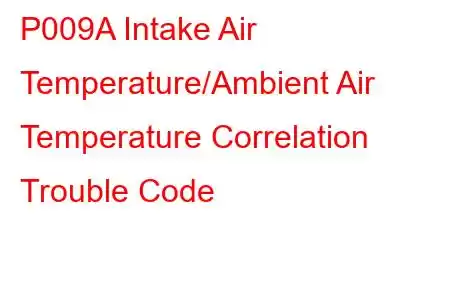P009A Intake Air Temperature/Ambient Air Temperature Correlation
OBD-II Trouble Code Technical Description
Intake Air Temperature/Ambient Air Temperature Correlation
What does that mean?
This generic powertrain diagnostic trouble code (DTC) typically applies to many OBD-II vehicles. That may include but is not limited to vehicles from Mercedes-Benz, Jeep, Mazda, Ford, etc.
If you have a service engine soon lamp accompanied by a code P009A, it means that the powertrain control module (PCM) has detected a discrepancy in the correlating signals between the intake air temperature (IAT) sensor and the ambient air temperature sensor. IAT and ambient air temperature must be monitored in comparison to ensure that no obstructions impede vital air flow to the engine intake.
IAT sensors are normally composed of a thermal resistor that protrudes from a plastic housing on a two-wire pedestal. The sensor is inserted into the air intake pipe or air filter housing. A secondary IAT sensor design integrates the sensor inside the mass air flow (MAF) sensor housing. Sometimes the IAT thermal resistor is positioned parallel with the MAF hot wire and other times it is located in a recessed area away from air flow. Check IAT sensor location specifications for the vehicle in question before making any assumptions.
The thermal resistor is usually positioned so that intake air may flow across it. The sensor housing is typically designed to be stuffed into its mounting point through a thick rubber grommet. As intake air temperature increases, the level of resistance in the IAT resistor decreases; causing circuit voltage to move towards the reference maximum. When air is cooler, IAT sensor resistance increases. That results in decreased IAT sensor circuit voltage. The PCM sees these variations in IAT sensor signal voltage as changes in intake air temperature.
The ambient air temperature sensor acts in much the same manner as the IAT sensor. The ambient air temperature sensor is normally positioned near the grill area.
A code P009A will be stored and a malfunction indicator lamp (MIL) may be illuminated if the PCM detects voltage signals from the IAT sensor and the ambient air temperature sensor which differ by more than the maximum allowable amount for a certain period of time. On some vehicle applications, MIL illumination may require multiple ignition cycles with a failure.
What is the severity of this DTC?
IAT sensor input is vitally important to fuel delivery and a stored code P009A should be classified as severe.
What are some of the symptoms of the code?
Symptoms of a P009A engine code may include:
There may be no symptoms exhibited with this code Engine drivability issues A reduction in fuel efficiencyWhat are some of the common causes of the code?
Causes for this engine code may include:
IAT sensor left unplugged after service Bad ambient air temperature sensor Faulty IAT sensor Open or shorted circuits or connectors Defective PCM or PCM programming errorWhat are some P009A troubleshooting steps?
Prior to diagnosing a P009A, I will require an infrared thermometer with a laser pointer, a diagnostic scanner, a digital volt/ohmmeter (DVOM), and a source of reliable vehicle information.
A stored IAT sensor code would prompt me to inspect the air filter element. It should be relatively clean and inserted into the housing as intended. A visual inspection of IAT sensor and ambient air temperature sensor system wiring and connectors should be undertaken if the air filter element seems to be functioning properly.
Next, I would connect the scanner to the vehicle diagnostic port and retrieve all stored codes and freeze frame data. I generally like to write this information down. It could prove helpful as the diagnostic process unfolds. Now, I would clear the codes and test-drive the v
Read: 47


